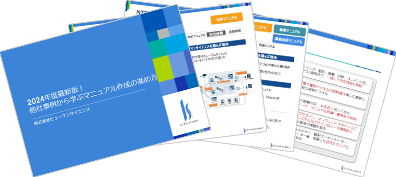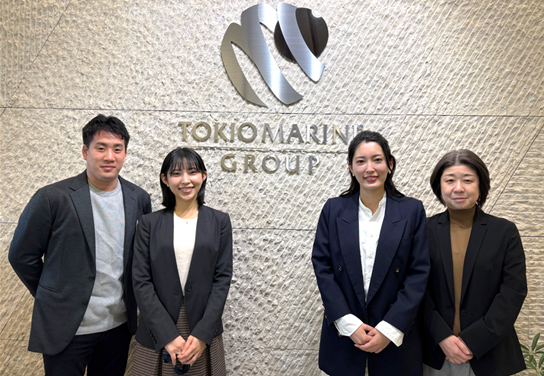


Interview Cooperation: Tokio Marine & Nichido Fire Insurance Co., Ltd.
Market Strategy Department, Regional Collaboration Office
(From left in the photo)
Project Response Team: Mr. Aoike, Mr. Oka<br/>Insurance Operations Response Team: Mr. Sumi, Mr. Nishikawa
Tokio Marine & Nichido Fire Insurance Co., Ltd. Company Overview
・Established: August 1879
・Capital: 101.9 billion yen
Number of Employees: 16,296 (as of March 31, 2024)
Business Activities: Non-life insurance business, agency and administrative services, management of defined contribution pension plans, outsourced automobile liability compensation business
Services and Initiatives
- ・Support for inventory and visualization of business operations and existing documents
- - Creation, improvement, and updating of business manuals
This is an example of how business improvements through manuals have spread throughout the Marketing Strategy Department.
It all started with the efforts of the project response team. In this team, as we progressed with a new project that we had never experienced before, we worked on developing manuals to create a common understanding among stakeholders with the support of human sciences. We began by inventorying and visualizing our operations based on a large amount of existing materials and interviews. After optimizing the business flow, we created the manuals.
As a result of this initial effort, the benefits of outsourcing the inventory and manual development of operations have gained attention both inside and outside the department, leading to horizontal deployment to other teams and departments.
This time, we spoke with Mr. Aoike and Mr. Oka from the Market Strategy Department's project response team, as well as Mr. Sumi and Mr. Nishikawa from the Insurance Operations Response Team, who were responsible for manual development in a separate task afterwards.
Reasons for Choosing Human Science
--Please tell us what prompted you to consider outsourcing your manuals.
Mr. Aoike: A few years ago, when we launched a new project, we needed a manual to distribute to our sales team and agents, and we prepared the materials in a trial-and-error manner. However, we received a lot of feedback saying that it was difficult to understand the overall picture and that it was unclear where to find the necessary information. We needed to improve it to make it more user-friendly, but due to the limited resources of the project members, it was difficult to make improvements in-house. Therefore, we considered whether we could outsource the manual creation.
--Please tell us the reason you chose Human Science.
Mr. Aoike: Since I had no experience outsourcing manual creation, I first searched online. That's when I came across Human Science. After checking their website, I felt a sense of reliability, so I decided to make an inquiry. I had concerns about security issues such as information leaks with outsourcing, but I felt reassured knowing they had a track record in the same insurance and financial industries as our company. Additionally, during the initial meeting, they thoroughly understood our challenges and requests, and their proposal to support us all the way to the inventory of operations, which is the preliminary stage of manual creation, was also a key factor in our decision.
Manual Improvement Dissemination within the Department
-- First, the project support team organized the manual. How did the efforts to organize the manual expand to the insurance operations support team?
Mr. Aoike: In a reporting meeting aimed at promoting collaboration between teams within the department, we shared that we outsourced the development of the manual. Members from other teams saw the improved clarity of the manual and raised the idea that "the challenges we face in our team could also be solved through outsourcing," which led to further discussions on this topic.
-- How did the insurance operations support team feel about the examples of manual development from the project support team?
Mr. Sumi: The manual I saw at the presentation was improved in a systematic and easy-to-understand way from a third-party perspective, which made outsourcing appealing to me. Our team had quite a few manuals, but they were scattered and not organized systematically, making it difficult to understand their interrelations, and the members were not in a position to utilize them effectively. Therefore, we wanted to organize the manuals and establish a framework to make it easier to find the necessary information. I asked Mr. Aoike about how to inventory the operations of Human Science, and I thought our challenges could also be solved through outsourcing, so I consulted with him.
Mr. Nishikawa: When the person responsible for the work creates the manual, it inevitably becomes difficult to understand, and there are also time constraints. While feeling challenges in organizing manuals within the company, I learned about the case of the project response team and thought that outsourcing to achieve this level of quality in manuals is a good option.
Project Approach
--Everyone, what did you feel while working on the manual maintenance?
Mr. Aoike: In our company, the handover of operations has often been done verbally, and I have the impression that many people, including myself, are not good at putting things into writing. Before we engaged Human Science, we had quite a few discussions among team members about the new project. However, figuring out how to document it in a way that would appropriately convey the information to stakeholders was initially a challenge. Human Science supported us from the inventory of operations, and they helped us to ensure that the parts we wanted to document were thoroughly incorporated into the manual, which was a great help.
Mr. Oka: I think that if we had tried to create the manual ourselves right away, we would have gotten stuck, gone back, and not been able to proceed smoothly. At first, I didn't understand, but after actually moving forward, I felt that the biggest appeal of requesting Human Science is being able to receive objective and easy-to-understand output after systematically organizing our operations and documentation.
Mr. Sumi: After reviewing the materials provided in advance, we discussed what kind of manual we aimed to create and consolidated our direction before conducting the hearing. Through the questions during the hearing, we were able to notice parts that were unclear from a third-party perspective. It was very helpful to have them cover points that we tend to overlook ourselves.
Mr. Nishikawa: Our operations did not have no manuals at all, but the information was scattered. We were grateful to have it consolidated and organized in a unified format.
Effects of Manual Maintenance
--After completing the manual maintenance, what effects did the project response team feel?
Mr. Aoike: In the internal survey regarding the project, we received many comments such as, "The overall picture has become clearer" and "The manual was very helpful." Recently, there have been instances where business personnel pointed out omissions in reflecting changes, which I see as evidence that the manual is being utilized on-site, and I feel the effectiveness of the manual's organization. Additionally, although it was not initially anticipated, the manual is also being used for business handovers, which has reduced the burden on transferees and new members, and this is one of the achievements.
Mr. Oka: We conduct regular internal training for about 1,300 to 1,400 people. By providing explanations based on the manual, we have seen an improvement in understanding, which has led to a decrease in the number of inquiries and an improvement in the quality of inquiries. I joined the project midway, but I was able to engage smoothly in the project after understanding the business content by referring to the manual, which I found very helpful.
What kind of effects did you feel from the insurance business support team?
Mr. Sumi: When the new member was assigned, we quickly utilized the new manual. By consolidating the scattered manuals into one and visualizing the workflow, both the instructors and the learners were able to communicate without missing any information, and the learners could understand their position, which I believe contributed to their sense of security. Some of the new members may feel hesitant to ask others when they have questions. Having something to refer back to on their own may also help reduce stress.
Future Plans and Outlook
-- Finally, please share your future vision and outlook.
Mr. Oka: Our company operates in an environment with frequent transfers and relocations. It is not an exaggeration to say that documenting our work is the most important initiative to ensure that we can carry on our responsibilities with the same enthusiasm, even when our roles and environments change. Ultimately, I believe this leads to sustainable practices. Creating operation manuals also contributes to building a system that connects our thoughts, and I have learned the importance of this. I would like to continue maintaining the manuals in the future.
Mr. Sumi: I would like to create training video content for our operations using the manual. By providing an environment where new members and those who have transferred can smoothly start their work, I aim to improve the overall productivity of the organization.
Mr. Nishikawa: Rather than just "creating and finishing" the manual, I want to maintain a state where we can regularly review and improve it, providing the latest information at all times. While it is important to provide flat information when creating the manual, I also want to continue to find ways to convey enthusiasm.
Related Services & Blog
Creation of Manuals and User Guides
Manual Creation In-house Support Service
Manual Evaluation, Analysis, and Improvement Proposal Service
Manual creation seminar and training
Thorough introduction of case studies on manual creation from other companies!Learn from case studies of other companies
How to proceed with manual creation
Before starting to create a manual, by learning about other companies' manual creation examples, you can understand the "key points of creation" and "common challenges" to gain hints for manual creation.
Recommended for
- I want to proceed with manual creation, but there is too much volume, and I don't know where to start.
- ・I am unsure if I can accomplish what I want to do in-house
- ・I want to know how other companies are progressing with manual creation

[Introducing Companies]
- TOTSUMEDIA Inc.
- BANDAI SPIRITS CO., LTD.
- NTT DATA KANSAI CORPORATION
- SBI SECURITIES Co.,Ltd.
- NNTTDATA CUSTOMER SERVICE CORPORATION
- WingArc1st Inc.
- Nippon Sheet Glass Co., Ltd.


